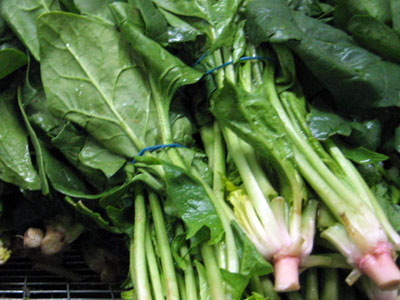|
Spinach
(Spinacia Oleracea)
Description:
 Spinach (Spinacia Oleracea) is an annual plant, long cultivated for the sake of its succulent leaves, a native of Asia, probably of Persian origin, being introduced into Europe about the fifteenth century. Eating and preparing spinach is simple and easy, since it tastes good raw or cooked. Spinach can be found fresh, frozen, or canned and can be easily incorporated into many dishes. Its versatility makes it easy to serve raw in salads and sandwiches or as a complement in soups, meat, fish, or other vegetable dishes. In addition to being tasty, spinach’s popularity stems from its high nutritional value. Not only is spinach low in calories, it is also a good source of iron and essential nutrients such as vitamins A and C, minerals, and fiber. Spinach is an important leaf vegetable, now grown throughout the temperate regions of the world. It is most productive in cool seasons and climates, since heat will cause the spinach to go to seed too early. When cooked, its volume is decreased by three quarters. Spinach (Spinacia Oleracea) is an annual plant, long cultivated for the sake of its succulent leaves, a native of Asia, probably of Persian origin, being introduced into Europe about the fifteenth century. Eating and preparing spinach is simple and easy, since it tastes good raw or cooked. Spinach can be found fresh, frozen, or canned and can be easily incorporated into many dishes. Its versatility makes it easy to serve raw in salads and sandwiches or as a complement in soups, meat, fish, or other vegetable dishes. In addition to being tasty, spinach’s popularity stems from its high nutritional value. Not only is spinach low in calories, it is also a good source of iron and essential nutrients such as vitamins A and C, minerals, and fiber. Spinach is an important leaf vegetable, now grown throughout the temperate regions of the world. It is most productive in cool seasons and climates, since heat will cause the spinach to go to seed too early. When cooked, its volume is decreased by three quarters.
Uses:
Fresh spinach is a great way to start a healthful salad. Just add other colorful vegetables or fruits, a few nuts or seeds and your favorite dressing. Fresh spinach also makes a great addition to sandwiches. Large leaves add a delicious crunch while baby spinach leaves add beautiful color. Steamed or stir-fried spinach makes a great side dish. Try adding some garlic for greater flavor or add chopped spinach to spaghetti sauce. A spinach and feta pie is a favorite pastry here in Cyprus.
Medicinal Value:
Spinach is relatively rich in nitrogenous substances, in hydrocarbons, and in iron. It is thus more nourishing than other green vegetables. It is a valuable part of the diet in anemia, not only on account of its iron, but also for its chlorophyll. Chlorophyll is known to have a chemical formula remarkably similar to that of hemoglobin, and it is stated that the ingestion of chlorophyll will raise the hemoglobin of the blood without increasing the formed elements. The plant contains from 10 to 20 parts per 1,000 by weight of chlorophyll. During the First World War, wine fortified with Spinach juice 1 in 50) was given to French soldiers weakened by severe bleeding. Spinach has a large nutritional value, even if steamed, or quickly boiled. It is a rich source of Vitamin A, Vitamin C, Vitamin E and several vital antioxidants. It is a source of folic acid, and this vitamin was first purified from spinach. To benefit from the folate in spinach, it is better to steam it than to boil it. Boiling spinach for four minutes can halve the level of folate.
Special Note:
Iron and calcium in plant foods are not highly absorbed by the body. Spinach contains a chemical called oxalic acid, which binds with iron and calcium and reduces the absorption of these minerals. To improve iron absorption, spinach should be eaten with vitamin C-rich foods such as orange juice, tomatoes, or citrus fruit.
Production and Packaging:
Seeding for the fresh produce harvest begins early in autumn through to March and the main commercial harvest period runs from November to early May. Fresh spinach is usually harvested in bunches of 250grms washed and pre-cooled before packing. Produce is packed either loose or in liner bags in cartons boxes unless demanded otherwise by the customer and shipped to destination markets normally within 24hrs from harvest.
|